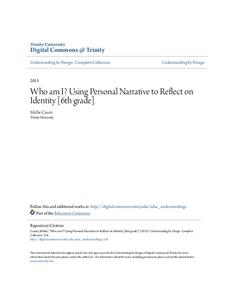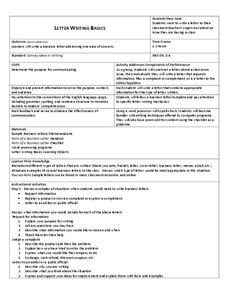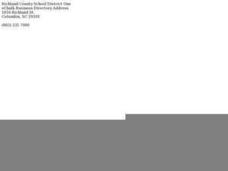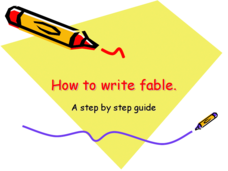Museum of Tolerance
Family Role Model Activity
What does is take to be a role model? Through grand conversation, and the use of books and a graphic organizer, scholars find out and apply the requirements to identify a role model within their family. They then journey through the...
California Education Partners
My Librarian is a Camel
A two-part assessment challenges scholars to gather information from reading then write an opinion piece. In part one, learners read, take notes, and answer text-related questions. In part two, participants use their new-found knowledge...
Novelinks
Walk Two Moons: Guided Imagery
Sensory details can enhance the reading experience, especially during a guided imagery reading. Young readers close their eyes and listen to a passage from Sharon Creech's Walk Two Moons before responding to discussion questions and...
California Education Partners
We Are The Ship
An assessment sheds light on scholars' ability to read, gather evidence, and draft an original written composition. Learners read an informative text twice before taking notes and discussing their thoughts and textual evidence with a...
Trinity University
Who Am I? Using Personal Narrative to Reflect on Identity
Who am I? Pupils work to answer this question through a unit that explores personal narratives and identity. Exit tickets for activities that examine different poems, short stories, and autobiographical writing serve as prewriting for...
Curated OER
Dialogue Tags
Use a presentation on dialogue tags in a narrative writing unit or a literature lesson. The first two pages of the resource detail the information and examples in the following slide show, making it a good reference page for your...
Civil War Trust
The Common Civil War Soldier
Imagine you are a soldier in the Civil War. What are you wearing? What do you need to carry with you? Examine the life of a person during the Civil War, from drummer boys to powder monkeys to musket-toting soldiers. Elementary...
Teach-nology
Author’s Purpose
What is the author's purpose in writing a joke book? What about a book about the digestive system? Explore author's purpose with a activity that challenges kids to identify whether ten books are meant to entertain, inform, or persuade.
Curated OER
Fairy Tales
Once upon a time are four words most children are familiar with when reading a fairy tale. But do they know that fairy tales are a great way to learn the literary elements of reading and writing? Use a thorough fairy tale unit...
Curriculum Corner
Summary Writing
Nineteen stylish worksheets offer lesson ideas and practice opportunities designed to reinforce summary skills. Scholars recall events over the weekend as well as favorite books—main characters, problems, solutions, the beginning,...
Curated OER
Letter Writing Basics
Students write a business letter with information regarding specific writing mechanics. In this writing lesson plan, students learn to write a business letter and they focus on one area of concern. Students follow a business letter...
Curated OER
Writing a Letter to a Friend
First graders practice their letter writing skills by writing to a fictional character. For this formal writing lesson, 1st graders read the books The Jolly Postman and Frog and Toad are Friends to examine the different parts of a...
Curated OER
Write Me a Story
Second graders use the writing process and submit a story to www.kids.com. In this story writing lesson, 2nd graders choose a topic for a story contest. Students develop their stories. Students complete a her...
Curated OER
The Writing Process
In this writing as a process instructional activity, students explore how writing is a process instead of a finished piece of work. Students also test out how to mind map a story.
Curated OER
Types of Sentences
In this language arts worksheet, students practice their skills in writing and placing punctuation marks for exclamatory, declarative, imperative, and interrogative sentences. Students complete 16 problems, and an answer key is provided....
Curated OER
How Can We Write A Story Using Dr. Seuss' Writing and Illustration Style?
Students write a story. In this writing style and illustration instructional activity, students review elements of Dr. Seuss' writing and illustration style and read a few more books written by him, examining the writing...
Curated OER
Writing Folktales
Students consider the structure of folktales. In this writing skills instructional activity, students list the attributes of folktales that they read in class. Students then complete handouts based on the elements of the tales as well as...
Curated OER
How can we write a silly story?
Second graders use the writing process and create a silly story. In this silly story lesson, 2nd graders will review person, event and setting and complete a chart for each. Students will put a person, event and setting...
Curated OER
Kinds of Sentences
Help your students mix up their writing with different kinds of sentences with this PowerPoint. Each slide gives a brief definition of the various types including: declarative, interrogative, imperative, and more! There are also examples...
Curated OER
Determining Author's Point of View: The Sneeches
Determine the author's point of view in a text. Young readers read Dr. Seuss' The Sneeches and identify the author's purpose in the story. They identify persuasive techniques in writing, asking and answering questions to better...
Curated OER
"I Can” Common Core! 6th Grade Writing
It is impossible to know whether one has reached a goal without first knowing the goal. Help your sixth graders reach all the Common Core writing standards by giving them a checklist written in language they will understand. As you teach...
Curated OER
Condensation Polymerization: Preparation of Two Types of Polyesters
College-level or AP chemists use phthalic anhydride to synthesize two different polyesters, one linear and one cross-linked in structure. A detailed materials list and well-written procedures are provided on a lab sheet. Learners write...
Curated OER
Media Babies
What is a media baby? Discuss at what age children should be exposed to electronic media. After reading an article, they identify the types of media products for infants and toddlers. Learners will predict the effects of media on the...
Curated OER
How to Write a Fable
Have your class write fables using this resource. First, learners read fables, and then they discuss the characteristics of these types of stories. This could lead to a writing activity in which they write their own fables.
Other popular searches
- Types of Writing
- Types of Editorial Writing
- Types of Conflict Writing
- 4 Types of Writing
- Four Types of Writing
- Different Types of Writing
- Types on Nonfiction Writing
- Types of Writing Passages
- Types of Writing Coverage























